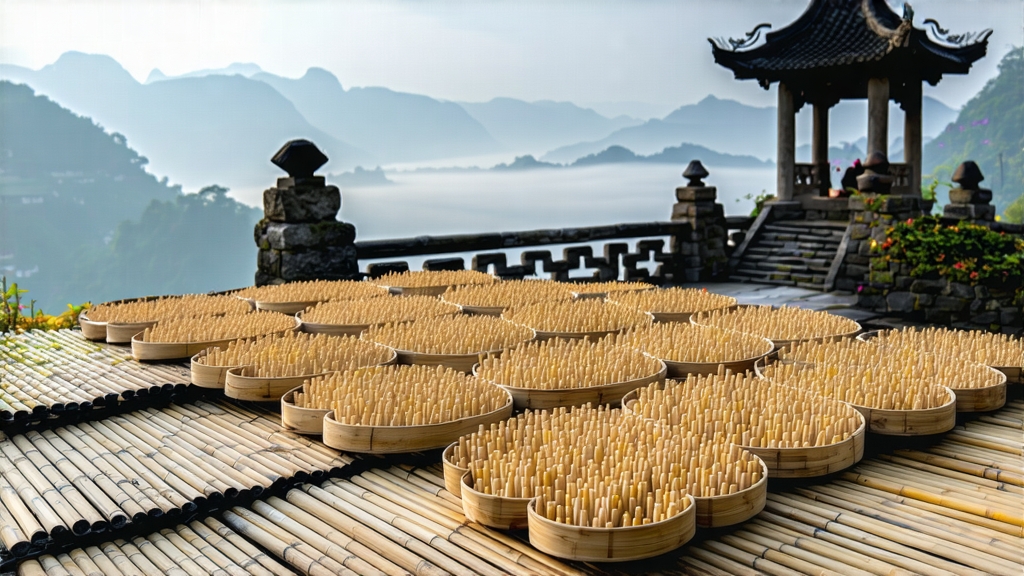
Tucked high on the northern rim of the Sichuan Basin, the Meng Ding range has been shrouded in cloud and legend since the Han dynasty. It was here, in 53 BCE, that the monk Wu Lizhen planted seven tea bushes on the summit of Shangqing Peak, an act later celebrated as the birth of cultivated tea in China. Among the several teas that still descend from those mist-laced gardens, none carries more imperial cachet than Meng Ding Huang Ya—literally “Meng Ding Yellow Bud.” While green teas stole the limelight of literature and black teas rode the clipper ships to Europe, this yellow tea remained a palace secret, pressed into small cakes and carried in silk pouches to Tang and Song emperors who believed its golden liquor could “illuminate the mind and clarify the breath.” For a thousand years it was virtually unknown beyond the court and the monasteries that guarded the seeds. Only after the 1950s state-led tea surveys did it re-emerge, yet even today fewer than 3 000 kg of authentic summit-grade Huang Ya are produced annually, making it rarer than silver-tipped Darjeeling or pre-Qingming Long Jing.
Botanically, Meng Ding Huang Ya is picked from a local cultivar called “Shuixian zao” (Narcissus early), a slow-budding shrub that thrives in the mountain’s acidic yellow loam. The leaves are minute—one tender bud and an unopened leaf no longer than 2.5 cm—plucked during the five-day “spring window” when night temperatures still dip to 8 °C, locking in amino acids that later translate into a sweet, almost milky cup. Pickers climb 1 100 m before dawn so that the buds can reach the village workshop by 8 a.m., still beaded with dew and mountain perfume.
What transforms this handful of downy tips into yellow tea is the almost-lost craft known as men huang—“sealing yellow.” After a 70-second wok roast at 160 °C, the leaves are piled in hip-high bamboo drums lined with wet cotton. The lid is sealed and the drum wrapped in hemp cloth, creating a micro-fermentation chamber where residual heat and moisture hover at 35 °C and 65 % humidity. Every forty minutes the pile is gently turned by hand, allowing oxygen to edge in and oxidise the leaf margins just enough to turn them ochre while the heart stays jade. This slow suffocation, repeated for up to three nights, is the moment when chlorophyll quietly breaks into pheophytin and catechins polymerise into the mellow compounds that give yellow tea its hallmark “chestnut-sweet” note without the grassy bite of green tea or the tannic heft of oolong. When the leaf finally emerges it smells like warm rice milk, and a single bud can unfurl into a perfect miniature spear in hot water, suspended like a golden fishbone.
Roasting and men huang are followed by three alternating cycles of low-temperature baking (60 °C) and resting, each lasting twenty minutes. The master judges readiness by pressing a leaf against the inside of his wrist; when it collapses soundlessly and exhales a sigh of baked apricot, the tea is considered “tamed.” Final moisture is brought down to 5 %, yet the leaf remains pliable enough to survive the tight rolling that gives Meng Ding Huang Ya its elegant sword shape. Historically the tea was then steamed and compressed into 125 g discs called “long tuan,” emulating the Tang dynasty cake style; most modern makers leave it loose to satisfy contemporary aesthetics, but a few boutique workshops still hand-wrap tiny 5 g “imperial squares” in gold foil, reviving the tribute format.
To brew Meng Ding Huang Ya you need calm water and a steady wrist. Start with a tall glass or a 150 ml gaiwan; porcelain accentuates brightness, while glass lets you watch the slow ballet of buds. Water should be spring quality, filtered but not distilled, and cooled to 80 °C—any hotter scalds the amino acids, any cooler fails to coax the lipids that carry aroma. Use 3 g of leaf (roughly a level tablespoon) and rinse for only two seconds; this “awakening” pour is discarded not for cleanliness but to prime the cells. The first formal infusion lasts forty-five seconds and delivers a liquor the colour of early morning chardonnay. Lift the cup to your nose: top notes are steamed maize and fresh lychee, followed by a deeper scent